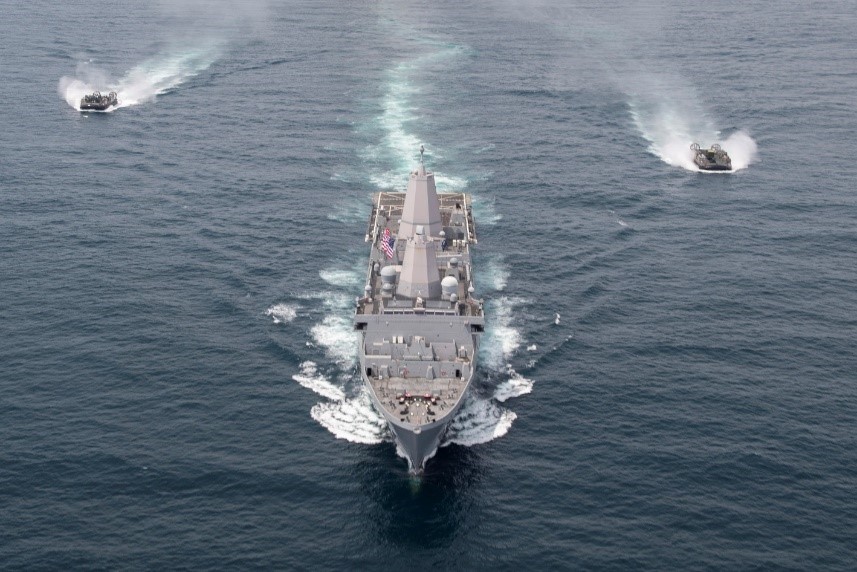Program Summary
LPDs are used to transport and land Marines, their equipment, and supplies by embarked Landing Craft Air Cushion (LCAC) or conventional landing craft and Amphibious Assault Vehicles (AAV) augmented by helicopters or vertical take-off and landing aircraft (MV 22). These ships support amphibious assault, special operations, or expeditionary warfare missions and serve as secondary aviation platforms for amphibious operations. These ships perform a variety of expeditionary warfare missions and are designed to operate independently or as part of an Amphibious Task Force (ATF), Amphibious Readiness Group (ARG), Expeditionary Strike Group (ESG), or Joint Task Force (JTF).
 |
|
Two landing craft air cushions (LCAC) assigned to Assault Craft Unit (ACU) 5 fly behind the San Antonio-class amphibious transport dock ship USS Somerset (LPD 25). (U.S. Navy Photo by Mass Communication Specialist 2nd Class Kyle Carlstrom/Released)
|
The 26 ships of the San Antonio (LPD 17) class are a key element of the Navy’s seabase transformation. The LPD 17 San Antonio class is the functional replacement for over 41 ships including the LPD 4 Austin class, LSD 36 Anchorage class, LKA 113 Charleston class, and LST 1179 Newport class amphibious ships. The newly designated LPD Flight II ships (formerly LX(R)) will be the functional replacement for the LSD 41/49 Whidbey Island Class. LPD 17-29 are designated as Flight I, and Flight II begins with LPD 30.
Each ship encompasses more than 20,000 square feet of vehicle storage space and 28,000 cubic feet of cargo storage. Vehicle storage space is provided through a well deck design which allows for the transportation of LCAC’s or conventional landing craft. This capability is enhanced by the incorporation of a flight deck and hangar that accommodate Marine Corps helicopters and MV-22 Osprey tilt-rotor aircraft.
With a maximum speed in excess of 22 knots and total displacement of 24,900 tons, the San Antonio class is powered by four turbocharged diesel engines. The ship can transport a landing force of up to 800 Marines.
LPD 17, the first ship of the class, commenced construction in June 2000 and was delivered to the Navy in July 2005. Eleven LPDs have been delivered and commissioned since then, and they have completed a combined 21 deployments around the globe. LPD 28 and LPD 29 are under construction.
In 2018 the Navy made the decision to transition the LX(R) effort to a second flight of the LPD 17 design. LPD 30 will be the first of 13 planned LPD Flight II ships, for a total complement of 26 ships in the LPD 17 class. In a unique ship building initiative for the last two LPD Flight I ships, Fort Lauderdale (LPD 28) and Richard M. McCool (LPD 29) will incorporate design innovations and cost-reduction strategies based upon lessons learned and improved technologies. The ships will have a more traditional mast in place of the two Advanced Enclosed Mast/Sensors and an updated deckhouse and boat valley design. The ships will carry fewer troops and have slightly less vehicle stowage space but still have greater capacity than the legacy LSD 41/49 Class.
Updated Jan 2019